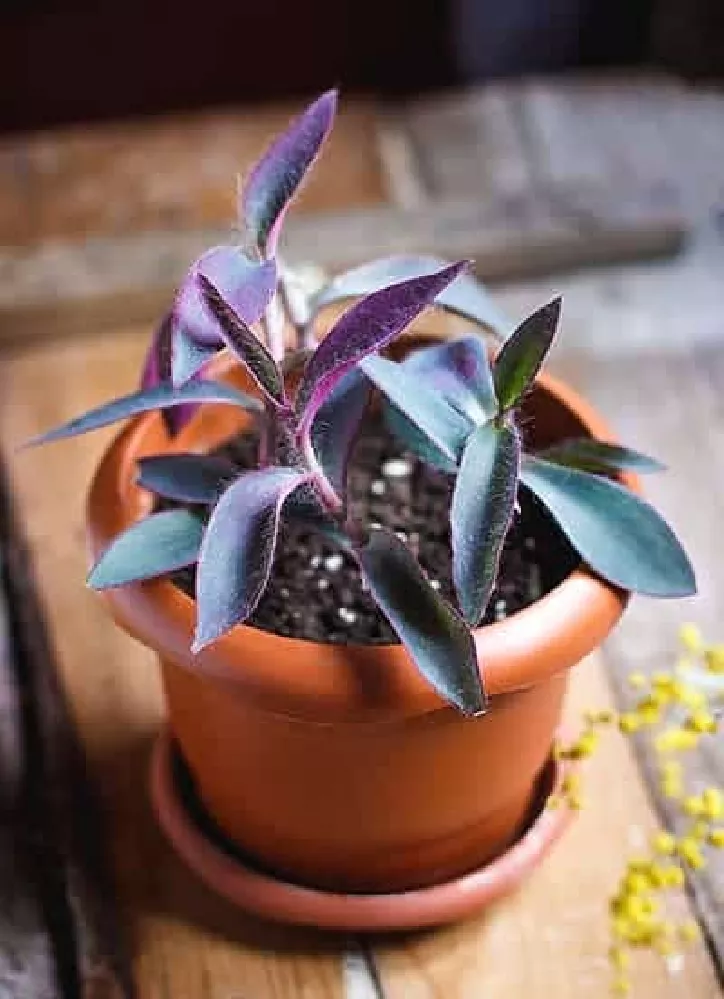- Home >
- Houseplants >
- Spiderwort Plants
Spiderwort Plants for Sale - Buying & Growing Guide
Fast Growing Trees - 3 Gallon - Blue Ginger Plant
Enter your zip code to find nearby stores that may carry this plant.
Spiderwort, or Tradescantia, is an easy-going flowering plant for USDA hardiness zones 4-9 that adds texture and color to the garden bed. Its blade-like foliage and purple-blue, reblooming flowers make it a good addition to a woodland or cottage garden but it also holds its own in more formal settings. A native of North, Central, and South America, it thrives in full sun or partial shade, needs little care, and rewards gardeners with month-long floral displays even in hot or dry conditions.
- Purple-blue tri-petal flowers make good garden accents.
- Easy care, with little extra care or supplemental watering needed.
- Grows well throughout most of the U.S.
Planting and Care
Planting instructions
Although Tradescantia can be grown as a houseplant, it is most often used in landscaping. It can be grown from seed but is readily available from nursery stock. Site your plant in a spot that gets four to six hours of sun a day, with soil that drains well, and is preferably slightly acidic. Dig a hole that is twice as wide as the root ball and just as deep. Place your young plant in the hole so it is at the same depth as it was in the nursery pot. Fill in around it with topsoil mixed with compost or well-rotted manure, tamping down as you go to eliminate air pockets. Water thoroughly when done and add an organic mulch around the plant.
Watering and nutrients
Spiderwort will need supplemental watering when first planted, every few days, until it is established and growing well. After that, it should only need watering if you are experiencing drought conditions. If you are growing Tradescantia indoors, water regularly when the top inch of soil is dry.
Indoor spiderwort will benefit from a light feeding of a balanced, slow-release fertilizer throughout the growing season but if you are growing your spiderwort outside, it will be fine with a single application of general-purpose fertilizer at the beginning of the growing season. If you wish to encourage growth after that, dig some well-rotted organic compost or manure into the soil around the plant.
Pruning
Once done blooming, your spiderwort may look somewhat raggedy and that is a good indication it will benefit from pruning. Lop off the top one-third of the plant, including the spent blooms, which will prevent them from reseeding. This should encourage new growth and may give you another bloom season later in the summer.
Pests and diseases
Spiderworts are fairly carefree when it comes to pests and diseases. If grown indoors, they may have issues with the usual foes of houseplants, aphids, mealybugs, and scale. They can be treated by cleaning the leaves with a cotton swab soaked in rubbing alcohol. Very few pests bother them outdoors.
Spiderwort given too much water, either indoors or out, may succumb to root rot. If that happens, cut back on the water and in extreme cases, you can try unpotting or digging up your spiderwort and letting it dry. Prune out the rotten roots and then replant them.
Achieving maximum results
Using spiderwort in your landscape design is not difficult. The plant will grow nicely anywhere you might consider placing an ornamental grass. Its long, blade-like leaves mimic the look of grasses, with the added benefit of the trefoil flowers. There are even a few varieties that feature variegated leaves, such as “variegated pink” Tradescantia.
It works best in a border, where its clumping form shows off nicely, or in an informal cottage garden setting. The flowers are usually bluish-purple but some varieties feature lavender or pink blossoms. If its flowers go to seed, the plant can become mildly invasive, so pruning is recommended to keep it under control.
FAQs
Is spiderwort easy to grow indoors?
Yes, it is easy to grow spiderwort inside. Plant it in a soilless mix or loamy potting soil and place it on a windowsill with bright indirect sun. Keep it pruned back to encourage bushy growth and water regularly whenever the soil is dry. Every few years, repot it, splitting the plant if it is outgrowing its container.
Do deer eat spiderwort?
One of the benefits of spiderwort is deer and other woodland creatures do not find it appealing. Rabbits also rarely bother it, so it is a good addition to gardens where wildlife is more likely to appear.
Is spiderwort toxic?
No, spiderwort is not toxic and in fact, the stems, leaves, and flowers have been used in folk medicine for centuries. Young leaves are edible if sauteed in olive oil. Indigenous Americans used spiderwort as a medical herb for treating spider bites and other purposes.
Can I grow spiderwort in shade?
Spiderwort in the wild grows as an understory plant in woodland areas. If you have a wooded area on your property, especially if the soil is rich with a layer of humus, you may be able to grow clumps of spiderwort under the trees if they get some dappled sunlight.
How tall does spiderwort grow?
If conditions are optimal, spiderwort can grow as tall as three feet but most varieties peak at a foot high. Some varieties are vine-like and are best grown draped over a hanging planter.









